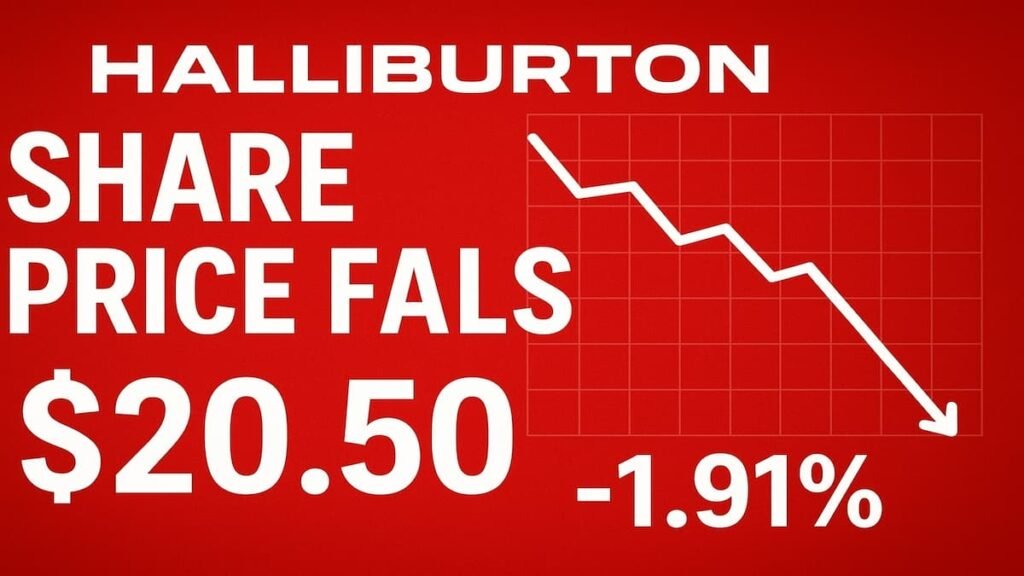Halliburton Co. (NYSE: HAL) saw its share price fall again on Tuesday. The stock traded at $20.50 per share, down 1.91% from the previous close. Investors are keeping a close eye on the oilfield services company as it remains far below its 52-week high.
The company has been struggling to regain momentum. Its highest price in the last year was $32.57, reached in November 2024. Since then, the stock has dropped about 37%. This decline has worried some investors but also attracted others who see a buying opportunity.
Current Market Position
Halliburton’s market capitalization is now around $17.48 billion. The company has a dividend yield of about 3.32%, paying $0.17 per share every quarter. The last ex-dividend date was June 4, 2025.
Today’s trading range was between $20.39 and $21.10. The total volume of shares traded so far is about 9.05 million, which is lower than the average of 15.9 million over the past 50 days. This shows that fewer investors are actively trading the stock compared to earlier weeks.
Analyst Views
Despite the drop in price, many analysts remain optimistic. The average 12-month target price for Halliburton is around $30.18. This would mean a potential upside of nearly 47% from the current level. Analysts also maintain a “Buy” rating, suggesting that they believe the stock can recover.
However, the market is unpredictable. Oil prices, demand for drilling services, and global economic conditions will all play a role in Halliburton’s future performance.
Comparison with Competitors
On Monday, Halliburton underperformed its main competitors.
- Schlumberger Ltd. was down about 1.52%.
- Baker Hughes Co. fell around 1.36%.
While the entire sector faced selling pressure, Halliburton’s decline was sharper. This could mean the market is reacting to company-specific concerns in addition to industry challenges.
Possible Reasons for the Decline
Halliburton operates in the oilfield services industry. This means its revenue depends heavily on the level of oil and gas exploration and production. If oil prices drop or drilling activity slows, Halliburton’s earnings can be affected.
In recent months, global oil prices have been volatile. Concerns about economic slowdown in major markets have also added uncertainty. At the same time, geopolitical tensions have made the energy market unpredictable.
What Investors Should Watch
For short-term traders, the $20 level could be an important support point. If the price falls below this, further declines may happen. For long-term investors, the focus will be on the company’s earnings reports, contracts, and the broader oil market outlook.
Dividend investors will also watch if Halliburton can maintain its payout. A steady dividend can attract buyers even during price declines. However, if the company cuts the dividend, the share price may fall further.
For more updates on stock market news and investment insights, visit moneyphobia.in.

Recent Posts
Tata Power-DDL launches Solar Sakhi Abhiyan
Next-Gen GST Reform: A Historic Diwali Gift for the Nation
Angel One Stock Broker Review
Income Tax Alert: ITR Filing Last Date for FY 2024-25 (AY 2025-26)
TikTok in India: The Buzz, the Ban, and What’s Really Happening
Wordle Answer Today (August 20, 2025): Hints and Full Solution Explained
Google Expands Store in India and Faces Global Play Store Challenges
Ola Electric Shares Recover Strongly After Heavy Fall in 2025
Gold Price Today: Rates Fall as Strong Dollar Impacts Market
Shreeji Shipping Global IPO Sees Strong Demand, GMP Suggests Listing Gains
India Approves ₹62,000 Crore Deal for LCA Tejas Mark 1A, HAL Shares Gain
Mangal Electrical and Gem Aromatics IPOs Draw Investor Attention with Steady GMP